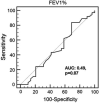Obstructive airway disease and obstructive sleep apnea: effect of pulmonary function
- PMID: 21132554
- PMCID: PMC3417329
- DOI: 10.1007/s00408-010-9270-3
Obstructive airway disease and obstructive sleep apnea: effect of pulmonary function
Abstract
This study sought to determine whether reduced pulmonary function in obstructive airway disease (OAD) is an independent risk factor for obstructive sleep apnea (OSA). This was a prospective observational study conducted at an outpatient pulmonary clinic. Adults with a known diagnosis of COPD/asthma were enrolled as OAD group. Family members without a history of COPD/asthma who accompanied these patients to the clinic were enrolled as a control group. The Berlin Questionnaire (BQ) was used to assess OSA risk in the OAD group and controls. Forced expiratory volume in 1 second (FEV(1) % predicted) was determined from spirometry. The subjects at high risk for OSA were referred for a full overnight polysomnogram (PSG). The prevalence of patients with a high risk of OSA was 55.2% in the OAD group, which was higher than in the controls (7.5%, p < 0.0001). OAD subjects had a higher body mass index (BMI) and larger neck circumference than controls (p < 0.01). There was no difference in FEV(1) % predicted between the OAD patients at high risk and low risk of OSA. On receiver operator curve (ROC) analysis, FEV(1) % predicted was not a significant predictor of high OSA risk. Using logistic regression, FEV(1) % predicted had no association with OSA risk. There was no correlation between FEV(1) % predicted and total apnea-hypopnea index (AHI), oxygen desaturation index, % time spent below oxygen saturation 90%, and mean oxygen saturation on multiple regression analysis. OSA appears to be common in patients with COPD or asthma in an urban outpatient pulmonary clinic. However, the high prevalence of OSA in OAD patients appears to be due to obesity, and reduced pulmonary function is not an independent risk factor for OSA.
Figures
Similar articles
-
Sleep Apnea and Obstructive Airway Disease in Older Men: Outcomes of Sleep Disorders in Older Men Study.Sleep. 2016 Jul 1;39(7):1343-51. doi: 10.5665/sleep.5960. Sleep. 2016. PMID: 27091524 Free PMC article.
-
Predictors and outcomes of obstructive sleep apnea in patients with chronic obstructive pulmonary disease in China.BMC Pulm Med. 2022 Jan 4;22(1):16. doi: 10.1186/s12890-021-01780-4. BMC Pulm Med. 2022. PMID: 34983482 Free PMC article.
-
Impact of obstructive sleep apnea on pulmonary hypertension in patients with chronic obstructive pulmonary disease.Chin Med J (Engl). 2019 Jun 5;132(11):1272-1282. doi: 10.1097/CM9.0000000000000247. Chin Med J (Engl). 2019. PMID: 30973448 Free PMC article.
-
Polysomnography in patients with obstructive sleep apnea: an evidence-based analysis.Ont Health Technol Assess Ser. 2006;6(13):1-38. Epub 2006 Jun 1. Ont Health Technol Assess Ser. 2006. PMID: 23074483 Free PMC article.
-
Obstructive Sleep Apnea in Patients with Chronic Obstructive Pulmonary Disease: Facts and Perspectives.COPD. 2021 Dec;18(6):700-712. doi: 10.1080/15412555.2021.1950663. Epub 2021 Oct 1. COPD. 2021. PMID: 34595967 Review.
Cited by
-
Polysomnography findings of patients with overlap syndrome according to severity of lower airway obstruction.J Res Med Sci. 2021 Dec 22;26:130. doi: 10.4103/jrms.JRMS_788_18. eCollection 2021. J Res Med Sci. 2021. PMID: 35126593 Free PMC article.
-
Eat, breathe, sleep with Osteogenesis Imperfecta.Orphanet J Rare Dis. 2021 Oct 18;16(1):435. doi: 10.1186/s13023-021-02058-y. Orphanet J Rare Dis. 2021. PMID: 34663416 Free PMC article.
-
Research Priorities in Pathophysiology for Sleep-disordered Breathing in Patients with Chronic Obstructive Pulmonary Disease. An Official American Thoracic Society Research Statement.Am J Respir Crit Care Med. 2018 Feb 1;197(3):289-299. doi: 10.1164/rccm.201712-2510ST. Am J Respir Crit Care Med. 2018. PMID: 29388824 Free PMC article. Review.
-
Evaluation of right ventricular remodeling using cardiac magnetic resonance imaging in co-existent chronic obstructive pulmonary disease and obstructive sleep apnea.COPD. 2013 Feb;10(1):4-10. doi: 10.3109/15412555.2012.719050. Epub 2012 Dec 28. COPD. 2013. PMID: 23272670 Free PMC article.
-
Association between the Risk of Obstructive Sleep Apnea and Lung Function: Korea National Health and Nutrition Examination Survey.Tuberc Respir Dis (Seoul). 2024 Jul;87(3):357-367. doi: 10.4046/trd.2023.0184. Epub 2024 Mar 18. Tuberc Respir Dis (Seoul). 2024. PMID: 38494836 Free PMC article.
References
-
- Tishler PV, Larkin EK, Schluchter MD, Redline S. Incidence of sleep-disordered breathing in an urban adult population: the relative importance of risk factors in the development of sleep-disordered breathing. JAMA. 2003;289:2230–2237. - PubMed
-
- Young T, Peppard PE, Gottlieb DJ. Epidemiology of obstructive sleep apnea: a population health perspective. Am J Respir Crit Care Med. 2002;165:1217–1239. - PubMed
-
- Auckley D, Moallem M, Shaman Z, Mustafa M. Findings of a Berlin Questionnaire survey: comparison between patients seen in an asthma clinic versus internal medicine clinic. Sleep Med. 2008;9:494–499. - PubMed
-
- Julien JY, Martin JG, Ernst P, Olivenstein R, Hamid Q, Lemière C, Pepe C, Naor N, Olha A, Kimoff RJ. Prevalence of obstructive sleep apnea–hypopnea in severe versus moderate asthma. J Allergy Clin Immunol. 2009;124:371–376. - PubMed


